Maritime Transport: The Largest Ports and New Trends in Global Maritime Logistics
A vital and dynamic part of international trade and logistics is the maritime industry. According to the United Nations Conference on Trade and Development, over 11 billion tons of cargo are being shipped each year. Considering the current population of the world, this translates to an incredible 1.5 tons per person.
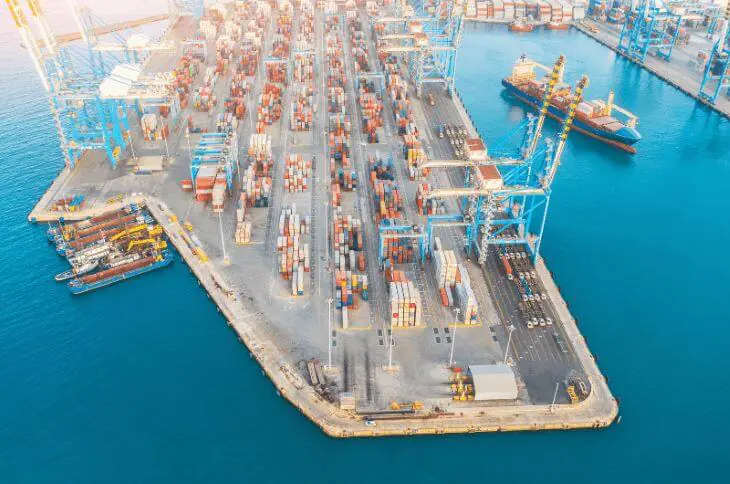
Source: www.canva.com
Ports are crucial in facilitating the transportation of commodities across borders because the majority of international trade is conducted via seaborne routes. We examine the biggest cargo ports in the world, give information on current trends in marine transportation, and look at developing patterns in international maritime logistics.
Largest cargo ports worldwide
The top 20 ports in the world handled a combined 382.8 million TEUs in 2022 (Lloyd’s List). Here are a few of them:
1. Shanghai, China (47,303,000 TEU)
The Port of Shanghai continues to accumulate astonishing volumes of cargo as the unchallenged leader in container port activity. Its advantageous location along the Yangtze River gives it access to China’s manufacturing hub. The port’s expansion mirrors China’s economic growth as it skillfully manages enormous trade flows on a domestic and international level.
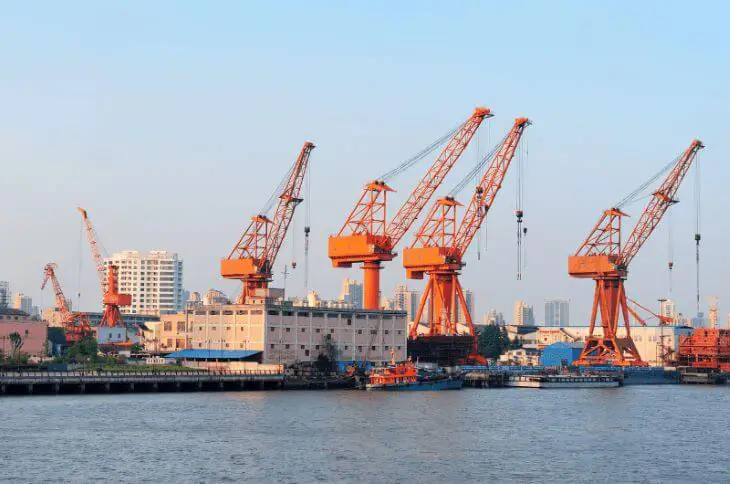
Source: www.canva.com
2. Singapore (37,289,600 TEU)
The second-busiest container port in the world is located in Singapore, sometimes called “Lion City”. Shipping lanes are marked by this marine behemoth, which provides unmatched connectivity. It has established itself as a global transshipment hub, easing the transportation of commodities between continents, thanks to its innovative infrastructure and effective operations.

Source: www.canva.com
3. Ningbo-Zhoushan, China (33,351,000 TEU)
Ningbo and Zhoushan, two ports, collaborated to claim the third position on the list. Their advantageous location on the Yangtze River Delta and close proximity to Shanghai have helped them rise to prominence. These ports serve as a prime example of China’s dedication to developing and improving its maritime commerce infrastructure.
4. Shenzhen, China (30,036,200 TEU)
The fourth-busiest cargo port is located in Shenzhen, which represents China’s quick ascent to economic dominance. Shenzhen, which consists of terminals like Yantian and Shekou, meets the demand for exporting goods from China’s center of production. Its rapid expansion is evidence of the nation’s export prowess.
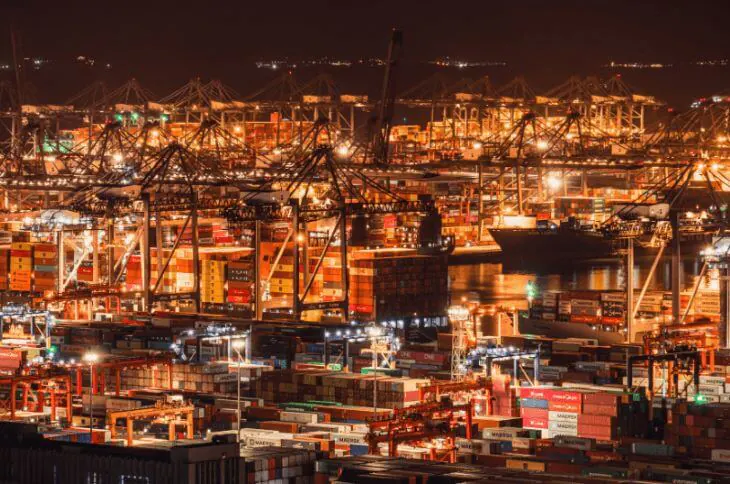
Source: www.canva.com
5. Qingdao, China (25,670,000 TEU)
The Port of Qingdao, located on China’s east coast, serves as a key hub for international trade. Its cutting-edge facilities and effective operations allow for the handling of large amounts of freight. Beyond national boundaries, Qingdao plays a vital role in the global trade of goods.
China has cemented its position as an unrivaled maritime trade giant by having several of its ports continuously rated at the top of world shipping container throughput lists. By embracing modern technology, China maintains its leadership in the world, improves logistics, and increases economic competitiveness. It has also been able to take advantage of its industrial expertise by strategically situating ports along important freight shipping routes, thereby transforming these ports into bustling hubs that handle enormous volumes of cargo.
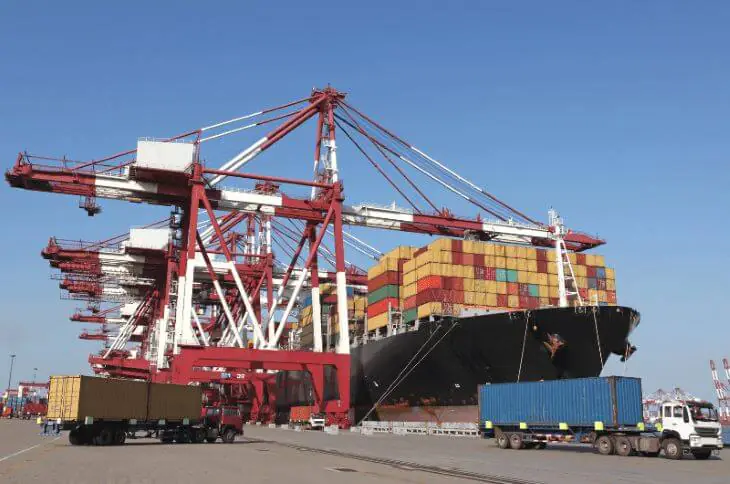
Source: www.canva.com
There are several other non-Chinese ports worth mentioning.
10. Rotterdam, Netherlands (14,455,000 TEU)
The Port of Rotterdam in the Netherlands comes in at number ten on the list, shattering the list’s Asian domination. Rotterdam, the largest port in Europe, serves as a hub for trade on the continent. It is a preferred entry and exit point for commodities entering Europe due to its advanced facilities and advantageous location.
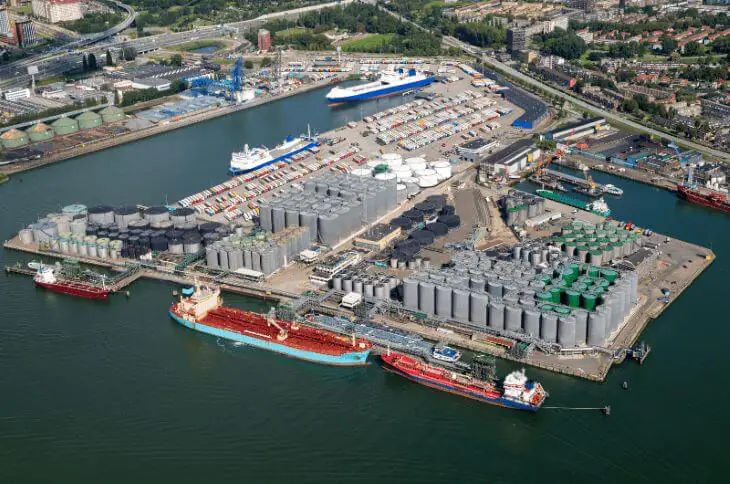
Source: www.canva.com
11. Dubai, UAE (13,970,000 TEU)
The 11th busiest container port is Dubai’s Port of Jebel Ali, representing the Middle East’s entryway to the world of commerce. It perfectly embodies Dubai’s desire to build itself as a trade and logistical hub because of its strategic location at the intersection of Europe, Asia, and Africa.
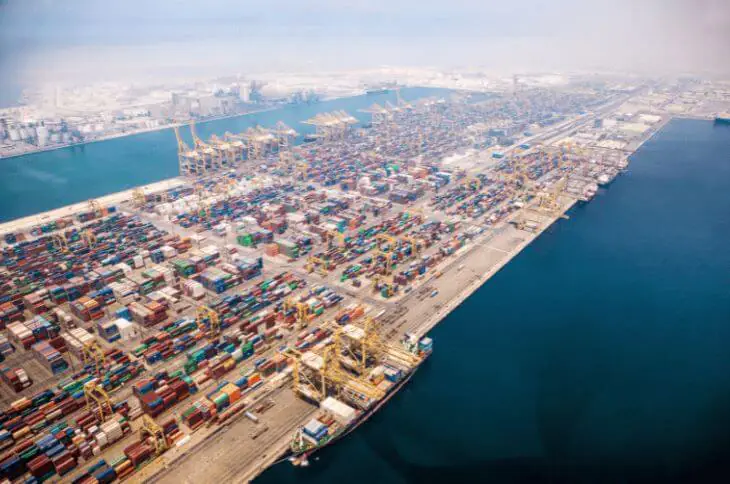
Source: www.canva.com
12. Antwerp, Belgium (13,500,000 TEU)
The fact that Antwerp’s port is ranked 12th shows how significant European trade is. This port, which is conveniently located in Belgium, is a crucial link connecting Europe to the world market.
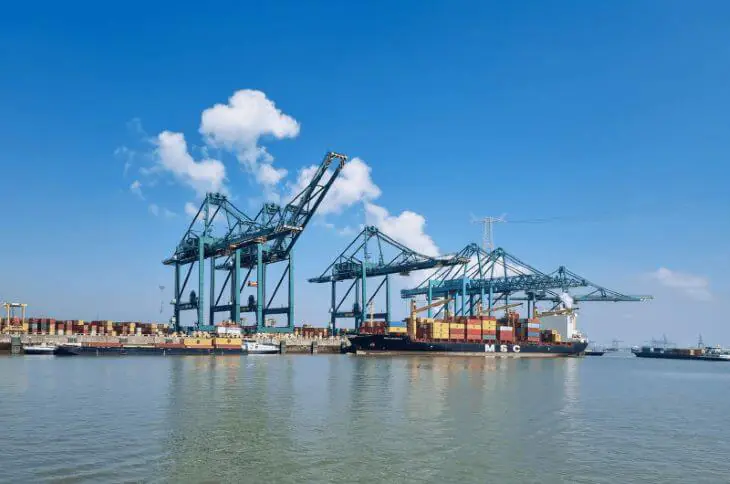
Source: www.canva.com
16. Los Angeles, USA (9,911,155 TEU)
The Port of Los Angeles, the largest port in the USA, takes the 16th position on the other side of the world. It manages a substantial share of the United States’ imports from Asia as a major participant in trans-Pacific trade. Its relevance to international marine logistics is furthered by its modernized facilities and closeness to important markets.
Using cargo ships with a capacity of up to 24,346 TEU, cargo is transported between all ports. Find out more about the biggest cargo ships that cruise the oceans worldwide. Now let’s look at the latest trends that are shaping the industry.
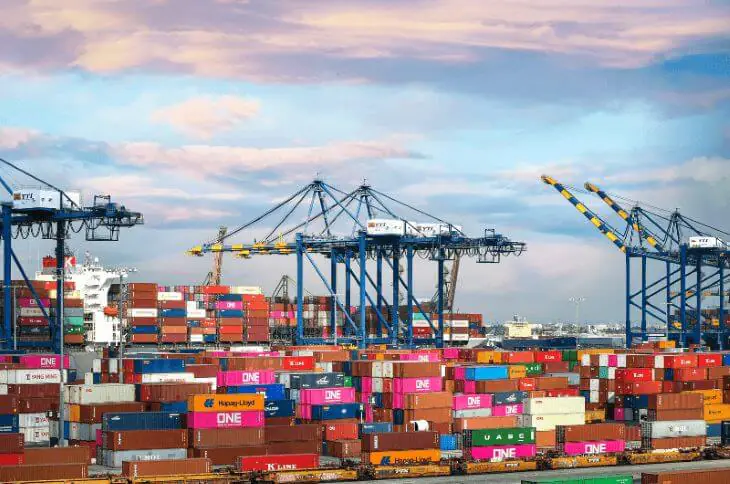
Source: www.canva.com
4 new trends in maritime logistics
A number of revolutionary factors are transforming the industry in the fast-paced world of international maritime logistics. Technological advancements, environmental concerns, and changing customer demands are the driving forces behind these new advances. They are strengthening supply chains, enhancing sustainability, increasing transparency, and reinventing how things are carried across oceans in order to keep up with the quickly evolving global economy.
In one of our articles, we discussed six trends that are shaping logistics globally. There are some major trends guiding the maritime logistics industry toward a future marked by higher effectiveness, decreased environmental impact, and increased responsiveness to the needs of the global economy of the twenty-first century.
1. Expanding green and blue economy
The global maritime fleet’s greenhouse gas emissions are going in the wrong direction. They increased by 23% between 2012 and 2022, with general cargo, dry bulk, and container ships accounting for the majority of the growth.
Both the green economy and the blue economy have their roots in sustainability, but they emphasize various facets of the environment and economic growth.
Green economy: By reorganizing the global economy in favor of such objectives, green economy trends aim to lessen the negative externalities on the planet and prevent climate change.
The implementation of renewable energy sources, the decrease of fossil fuel-based energy consumption, and, whenever practical, the adoption of a zero-waste strategy in industrial processes are all necessary steps in the direction of creating a low-carbon economy.
Study analysis (CE Delft) reveals that by using 5–10% zero or almost zero emission fuels, wind-assist devices, and ‘climate optimal’ ship speed, ships can reduce emissions by 36-47% from 2008 levels by 2030.
If you would like to become greener even without the use of cargo ships, read about how to do it.
Blue economy: The sustainable development of marine and coastal ecosystems is the main objective of the blue economy. It strives to preserve the health and biodiversity of oceans, seas, and coasts while maximizing their economic value.
A key principle of the blue economy is using more environmentally friendly fuels, pollution control systems, and energy-saving technology that would help cargo shipping leave less of a carbon imprint. These steps lessen air pollution, reduce fuel use, and lessen the impact of shipping on climate change and marine ecosystems.
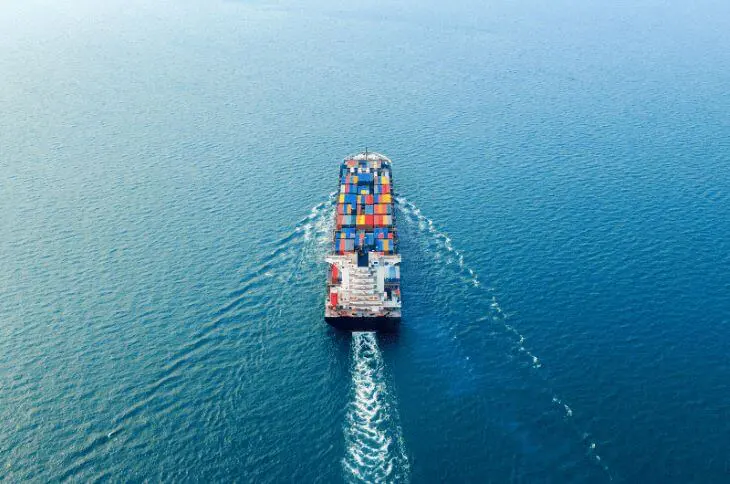
Source: www.canva.com
2. Use of autonomous ships
In the cargo shipping sector, automation and maritime autonomous surface ships (MASS) are bringing about a seismic revolution. These innovations are meant to lower labor costs, increase security, and improve navigation.
Automation significantly contributes to improving safety by reducing the likelihood of mistakes made by humans and accidents brought on by fatigue. Modern systems can monitor a ship’s systems, the weather, and navigational data in real-time, making modifications as needed to ensure safer and more comfortable voyages. Furthermore, automation helps optimize route planning and navigation by considering variables like traffic, weather, and fuel efficiency.
While autonomous vessels can function without human supervision, automation encompasses operations like cargo handling and engine control, possibly transforming cargo logistics in the future.
One example is the Norwegian container ship Yara Birkeland from Yara Company, the first emission-free, totally electric, autonomous container ship in the world. Yara will eliminate 40,000 annual trips made by diesel-powered trucks hauling goods with the help of this container ship.
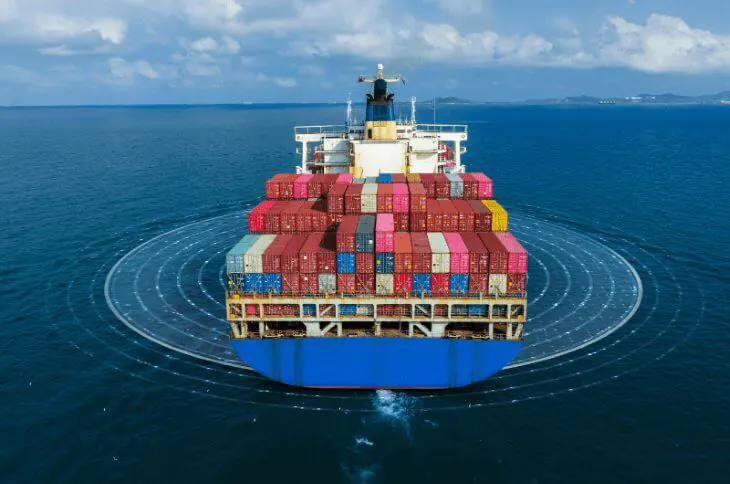
Source: www.canva.com
3. Digitalization and the Internet of Things (IoT)
Vessel management and operations are changing due to the seamless integration of digital technologies. Real-time insights into a vessel’s performance are provided by IoT sensors and connected systems to the IoT.
These sensors are essential for gathering information from the real world, which is subsequently sent to IoT systems or devices for processing, analysis, and decision-making. IoT sensors are used in various applications and are available in various forms to collect data about the environment, objects, and processes.
IoT sensors deployed aboard ships offer instantaneous performance analysis. These sensors gather information on a range of factors, including temperature, engine efficiency, fuel consumption, and cargo conditions. Preventative maintenance is made possible by the abundance of data, allowing ship operators to take care of prospective problems before they get out of hand. Additionally, it helps to increase fuel efficiency, which lessens the impact of maritime transportation on the environment.
Container tracking has also improved in accuracy and transparency. In an increasingly digitized age, this digital revolution increases operational effectiveness and decreases downtime. It also lowers costs, making maritime transport more competitive and ecological. Find out the 5 best online container tracking systems.
4. Making the supply chain more resilient
The COVID-19 pandemic’s impact on the world has served as a potent lesson on the significance of creating reliable and resilient supply chains. The logistical tactics have been fundamentally reevaluated as a result, with a renewed focus on preventative measures and thorough contingency planning.
Supplier diversification is a crucial tactic for improving supply chain resilience. Businesses can lessen the risk of disruptions by spreading out their reliance on only one source for crucial parts or supplies to multiple sources. To provide a more stable and adaptable supply network, this strategy comprises finding and fostering alternative suppliers both domestically and internationally.
A crucial exercise in determining and enhancing supply chain resilience is stress testing. Businesses can find vulnerabilities and weaknesses by simulating interruptions and crises by subjecting supply chains to them. This procedure enables the formulation of strategies to continue operations and reduce disruptions in the face of unforeseen circumstances, as well as the improvement of contingency plans.
Localized production is becoming more popular as a technique to boost resilience. Businesses can lessen their reliance on far-off suppliers by moving operations closer to important customers or carefully positioning manufacturing facilities. This strategy improves responsiveness to changes in demand and supply while also reducing transportation risks.
To improve the resilience of the supply chain, collaborative networks are becoming increasingly effective. The ability to pool resources and exchange knowledge is made possible through forging collaborative ties with suppliers, logistics providers, and even rival companies. These networks can provide a more coordinated and efficient response in times of interruption.
These developments will continue to influence how commodities are shipped across oceans and how trade is carried out as we sail into the future. It is a future in which maritime logistics not only propels economies but also plays a crucial part in preserving the ecology of our planet.
Companies are increasingly recognizing the importance of sustainability in their operations. One significant step toward a greener future is the adoption of innovative solutions, one of which could be using the EasyCargo software. This user-friendly application makes cargo loading more efficient, making the most of the available container space and lowering the need for further shipments. As a result, companies can dramatically reduce their carbon footprint as well as help create a healthier environment and cleaner air.




